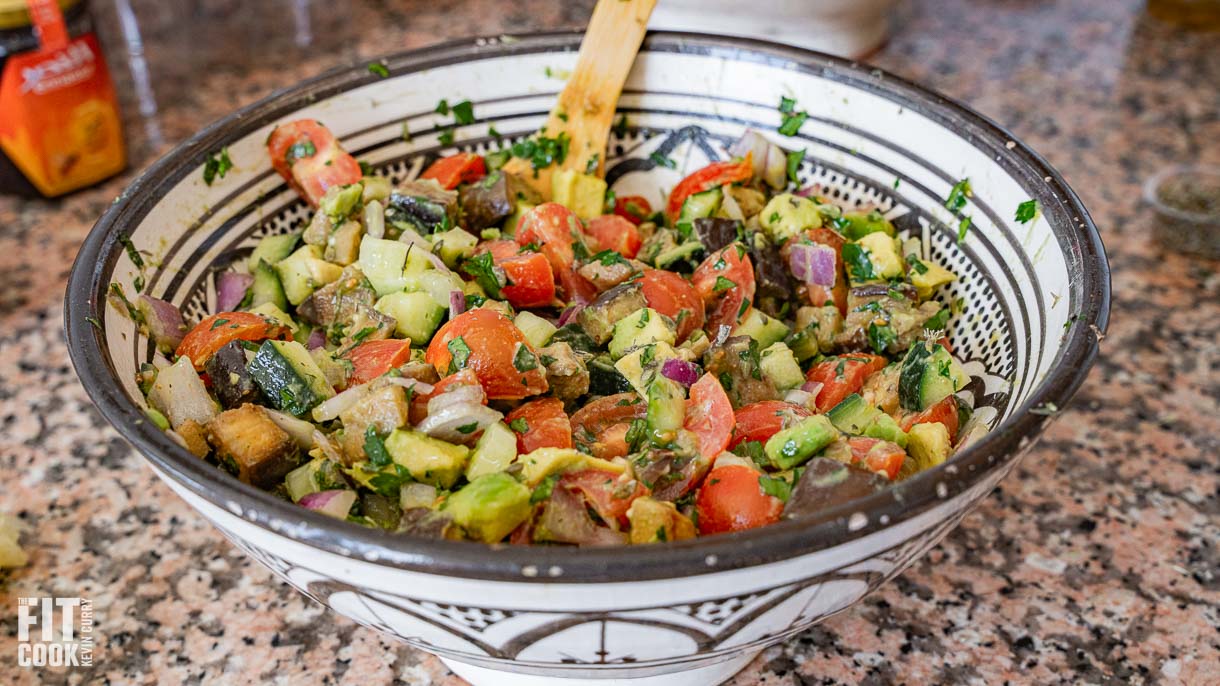[ad_1]
I spent most of January 2024 in Taghazout, Agadir, Morocco, a small surf and fishing village.
I went to the market nearly every morning to cook fresh food and meal prep so it felt great to have that as part of my daily routine. The only hiccup was that the selection of veggies and meat was limited being in such a small town.
But one ingredient that was almost always available? Eggplant. And after growing tired of eating the same avocado and tomato salad, I decided to throw in some eggplant, why? Eggplant absorbs flavor well, and when prepared a certain way, has a meaty texture.
How does eggplant become meaty?
There are several factors during the cooking process that influence the eggplant and transform its consistency. Eggplant, or aubergine as it’s known in many parts of Europe, is naturally rich in moisture and has a spongy-like flesh.
When eggplant is roasted, the meaty texture undergoes significant changes that contribute to the meat-like texture.
How to make eggplant meaty
The first step in achieving a meaty texture is salting the eggplant. I cannot emphasize this enough.
Salting helps draw out excess moisture while also removing the compounds that may give eggplant a bitter flavor. Roasting makes the eggplant less watery and more concentrated in the flavor of which you have seasoned.
While some shrinkage will occur, not nearly as much when salting is done and the eggplant generally retains its shape by expelling all the water first so it doesn’t shrivel in the heat.
How to salt an eggplant
Place the slices or pieces of eggplant on a paper towel. Add several pinches of sea salt over the pieces and let them rest for at least 30 minutes. There should be a lot of moisture on the paper towel.
To prevent the recipe from being too salty, simply rinse the eggplants under cold water and pat dry.
Roasting eggplant
Roasting at a high temperature further enhances its meaty texture. How? The intense heat causes the water inside the eggplant to evaporate, resulting in a drier, firmer interior which is why is retains its shape.
The purple, outer skin of the eggplant chars, producing a mouthwatering smoky flavor. This and any spices you may want to add, will bring depth to the overall taste and make it feel like meat in your mouth..
Further, the sugars in the eggplant flesh turn brown and become caramelized, creating a crispy, savory crust on the outside. This adds the satisfying, chewy element similar to meat that I love in these types of recipes.
How to use lavender in a dish
Lavender and thyme or oregano take the flavor of this to the next level because of the harmonious pairing of flavors and aromas. Lavender has delicate floral notes and a mild citrusy flavor.
This makes for a perfect pairing with herbs like thyme or oregano.
Got thyme for flavor?
Thyme and oregano have earthy, herbaceous, mild peppery undertones that counterbalance the floral sweetness of lavender to make it more woodsy.
These robust flavors provide a sturdy foundation for the salad, preventing it from becoming overly floral or perfumed. Additionally, both thyme and oregano meld seamlessly with avocados and tomatoes without being distracting.
And don’t forget the avocado! Besides the creamy richness it brings to the salad, this makes the salad heartier and heart-healthy.
Cherry tomatoes have juicy acidity and bright flavors to complement savory herbs, creating a well-rounded taste profile. The lavender, in moderation, is aromatic and adds a subtle layer of complexity without overwhelming the dish.
Want to try more recipes with eggplant?
[ad_2]
Source link





